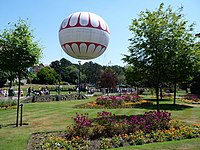Bournemouth typhoid outbreak of 1936
Appearance
| Date | August 1936–September 1936 |
|---|---|
| Location | Bournemouth, Hampshire |
| Cause | Typhoid fever |
| Outcome | 718 cases |
| Deaths | Appx. 70 |
The Bournemouth typhoid outbreak was an outbreak of typhoid in 1936 in the south coast of England, a traditional holiday location. It occurred during the months of August and September. The first cases were traced to raw milk from a dairy supplied by a farm whose cows drank water from a river contaminated by sewage from a cottage where a typhoid carrier lived. 718 people became infected, including 200 visitors and 518 residents.[1][2][3][4]
References
[edit]- ^ Cotes-Preedy, D. (17 April 1937). "The Bournemouth Typhoid Outbreak". British Medical Journal. 1 (3980): 825–826. doi:10.1136/bmj.1.3980.825. ISSN 0007-1447. PMC 2088641. PMID 20780616.
- ^ "The Bournemouth Outbreak of Typhoid Fever". Nature. 140 (3534): 145–146. 1 July 1937. doi:10.1038/140145d0. ISSN 1476-4687. S2CID 34597295.
- ^ "Typhoid outbreak, Bournemouth. (Hansard, 22 July 1937)". api.parliament.uk.
- ^ Smith, David F.; Diack, H. Lesley; Pennington, T. Hugh; Pennington, Thomas Hugh; Russell, Elizabeth M. (2005). Food Poisoning, Policy, and Politics: Corned Beef and Typhoid in Britain in the 1960s. Boydell Press. ISBN 1-84383-138-4.

